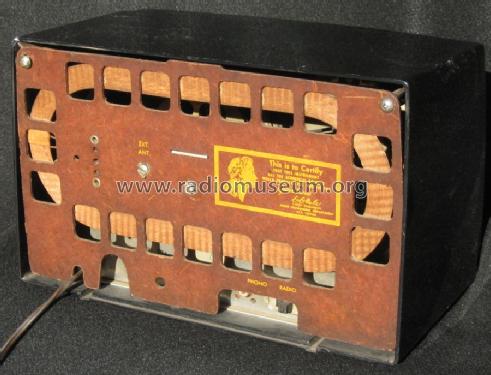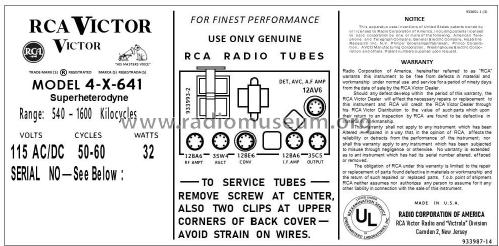4-X-641 Driscll Ch= RC-1140
RCA (RCA Victor Co. Inc.); New York (NY)
- Land
- USA
- Hersteller / Marke
- RCA (RCA Victor Co. Inc.); New York (NY)
- Jahr
- 1954

- Kategorie
- Rundfunkempfänger (Radio - oder Tuner nach WW2)
- Radiomuseum.org ID
- 91260
-
- anderer Name: RCA Manufacturing || Victor Talking Machine
Klicken Sie auf den Schaltplanausschnitt, um diesen kostenlos als Dokument anzufordern.
- Anzahl Röhren
- 6
- Hauptprinzip
- Super mit HF-Vorstufe; ZF/IF 455 kHz; 2 NF-Stufe(n)
- Anzahl Kreise
- 7 Kreis(e) AM
- Wellenbereiche
- Mittelwelle, keine anderen.
- Betriebsart / Volt
- Allstromgerät / Either AC 50 to 60 cycles, 115 Volts or DC 115 Volt
- Lautsprecher
- Dynamischer (permanent) Ovallautsprecher
- Belastbarkeit / Leistung
- 0.8 W (1.2 W max./spitze)
- Material
- Plastikgehäuse (nicht Bakelit), Thermoplast
- von Radiomuseum.org
- Modell: 4-X-641 Driscll Ch= RC-1140 - RCA RCA Victor Co. Inc.; New
- Form
- Tischmodell, Zusatz nicht bekannt - allgemein.
- Abmessungen (BHT)
- 11.25 x 7.125 x 6.375 inch / 286 x 181 x 162 mm
- Bemerkung
-
The RCA 4-X-641 is an AC/DC operated 6 tube BC band receiver. BC band tuning range is 540 to 1600kHz. Has phone input with radio/phono selector switch on rear of chassis. Has loop antenna with provisions for external antenna. Cabinet color is Black with Artic White speaker grill.
The following models use the same schematic and cabinet but have different cabinet colors:
Model Number Cabinet Color 4-X-641 Black and Artic White 4-X-643 Black and Chartreuse 4-X-644 Black and Brick Red 4-X-646 Ivory and Brick Red 4-X-647 Ivory and Dark Green 4-X-648 Ivory and Powder Blue "Driscll" is probably a spelling mistake in Stein.
- Nettogewicht
- 6 lb (6 lb 0 oz) / 2.724 kg
- Literatur/Schema (1)
- Beitman Radio Diagrams, Vol. 14, 1954 (Page 94)
- Literatur/Schema (2)
- - - Manufacturers Literature (RCA Service Data 1954 No. 4 Datasheet, second edition)
- Literatur/Schema (3)
- Machine Age to Jet Age II (page 233.)
- Autor
- Modellseite von Walter Wiesmüller † May 2012 angelegt. Siehe bei "Änderungsvorschlag" für weitere Mitarbeit.
- Weitere Modelle
-
Hier finden Sie 5180 Modelle, davon 3254 mit Bildern und 4217 mit Schaltbildern.
Alle gelisteten Radios usw. von RCA (RCA Victor Co. Inc.); New York (NY)
Sammlungen
Das Modell 4-X-641 Driscll befindet sich in den Sammlungen folgender Mitglieder.
Forumsbeiträge zum Modell: RCA RCA Victor Co.: 4-X-641 Driscll Ch= RC-1140
Threads: 1 | Posts: 3
Fellow radiophiles,
A while back I came across an RF transformer following the 12BA6 RF preamp of a 6 tube AC-DC Silvertone Radio, that had a fixed tuned primary. I did not understand the design purpose for this fixed tuned primary.
Recently, while restoring this RCA 6 tube AC-DC set, I noticed the same fixed-tuned primary at the RF transformer following the 12BA6 RF preamp. I had the set on the bench, so I decided to measure the RF transformer and simulate it's operation to learn how it worked.

The RF transformer is not shielded and is located at the lower half of the photo.
I measured the primary inductance of this transformer with the transformer in place, using my Rohde&Schwarz BN6100 inductance meter.
The inductance meter can be used to measure inductance and self-resonant capacitance, including external capacitance soldered to it's terminals.
I got 3mH with a Q=10 at 41kHz and a self-resonant capacitance of 70pF at 340kHz. The capacitance includes internal parasitics and the external 47pF.
Next, I measured the low frequency non-resonant transformer coupling ratio, and found 15:1 at 10kHz from primary to the top of the tapped secondary. I had the tuning dial at the top of the range.
The following model evolved as more measurements of voltage transfer were accumulated. Accounting for Q properly was very important to get reasonable model aggreement. RQp and RQs model the Q of the windings, beyond what is already implicit in the DC series resistances R3 R4 and R5.
Note the large 23pF self capacitance of the primary represented by C2.
I chose to break up the primary into two inductors for modeling purposes in LTspiceIV. Three inductors L1a, L2a and L2b form an ideally coupled transformer as defined by K12. The loosely coupled primary had 3mH of uncoupled inductance, and only around 200uH was coupled 100% to the secondary. This gave just under 10:1 coupling ratio, which I deemed close enough to the 15:1 measurement.
The components outside the dashed line box enclosing the transformer, correspond to components in the schematic, but I was a bit careless, and did not retain the same reference designators.
The 12BA6 RF preamp tube was modeled as a transconductor with 2mS. Somehow, my measurents could not summon up the full rated 4mS of transconductance, but the character of the gain is still correct.
The first multi point frequency sweep extablished the voltage transfer characteristic from the grid of the RF preamp to it's plate. The load is the low Q fixed tuned primary resonating at 340kHz, and the input test voltage was 130mVrms. A reasonable agreement was obtained between the table of measured values above and the simulated curve in the following plot by lowering the 12BA6 gm to only 2mS.
Each of the curves in this plot was done with the RF tuning capacitor at different positions, as listed in the ".step" simulation command. The straight curve without dips corresponds to tuning at 1.6MHz and also corresponds to the measured table.
The following plot shows the overall voltage transfer from RFgrid to Mixer grid. The marked values are in reasonable agreement with the table of measured values above. While the RF preamp does not add a lot of gain to the radio, in particular at the upper end of the band, it is very effective at improving image rejection with the steep decay above resonance.
The curves show a sharp notch that is common to all curves around 2MHz, which is just beyond the plot. This notch is caused by a resonance between the 2.2pF coupling capacitor and the 3mH primary.
Each curve represents a different tuning capacitance. Image rejection is most important when tuning below 1.2MHz, where a strong local station above this frequency will have a heterodyne image.
For example, my local 1.4MHz station has a heterodyne image 455KHz below 1.4Mhz, at 945kHz. The 1.4MHz station could be heard when the radio is tuned to 945kHz, unless the RF Loop and transformer reject this frequency. The green curve for tuning at 1MHz shows over 30dB of rejection for the image of a 1.4MHz signal. This rejection is added to the main loop antenna, which should be at least 40dB with loop Q=100. The overall image rejection should be around 80dB
It appears that the primary purpose of this RF transformer is to improve image rejection, while adding a modest amount of gain, up to 15dB at 560kHz, but the gain at 1.6MHz is about 0dB.
This tilt in gain complements the expected lower Q of the loop antenna at lower frequencies. The reduced loop reactance at lower frequencies lowers the Q, as the loop wire resistance becomes more significant compared to the inductive reactance.
The overall sensitivity of the set is clearly higher than that of 5 tube AC-DC set, and the resulting improvement in AGC from higher overall gain is very noticeable.
Regards,
-Joe
Joe Sousa, 20.Feb.10















